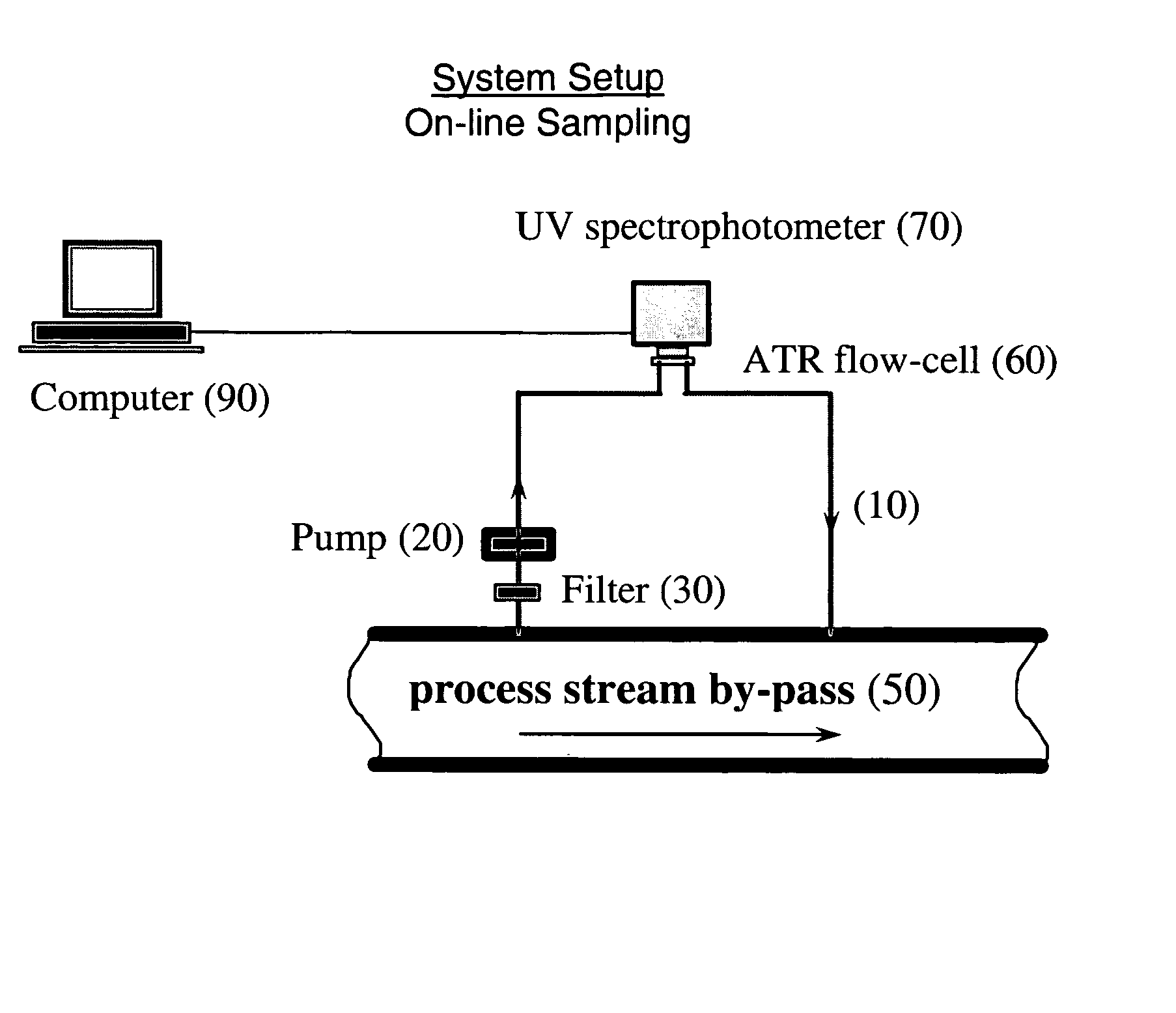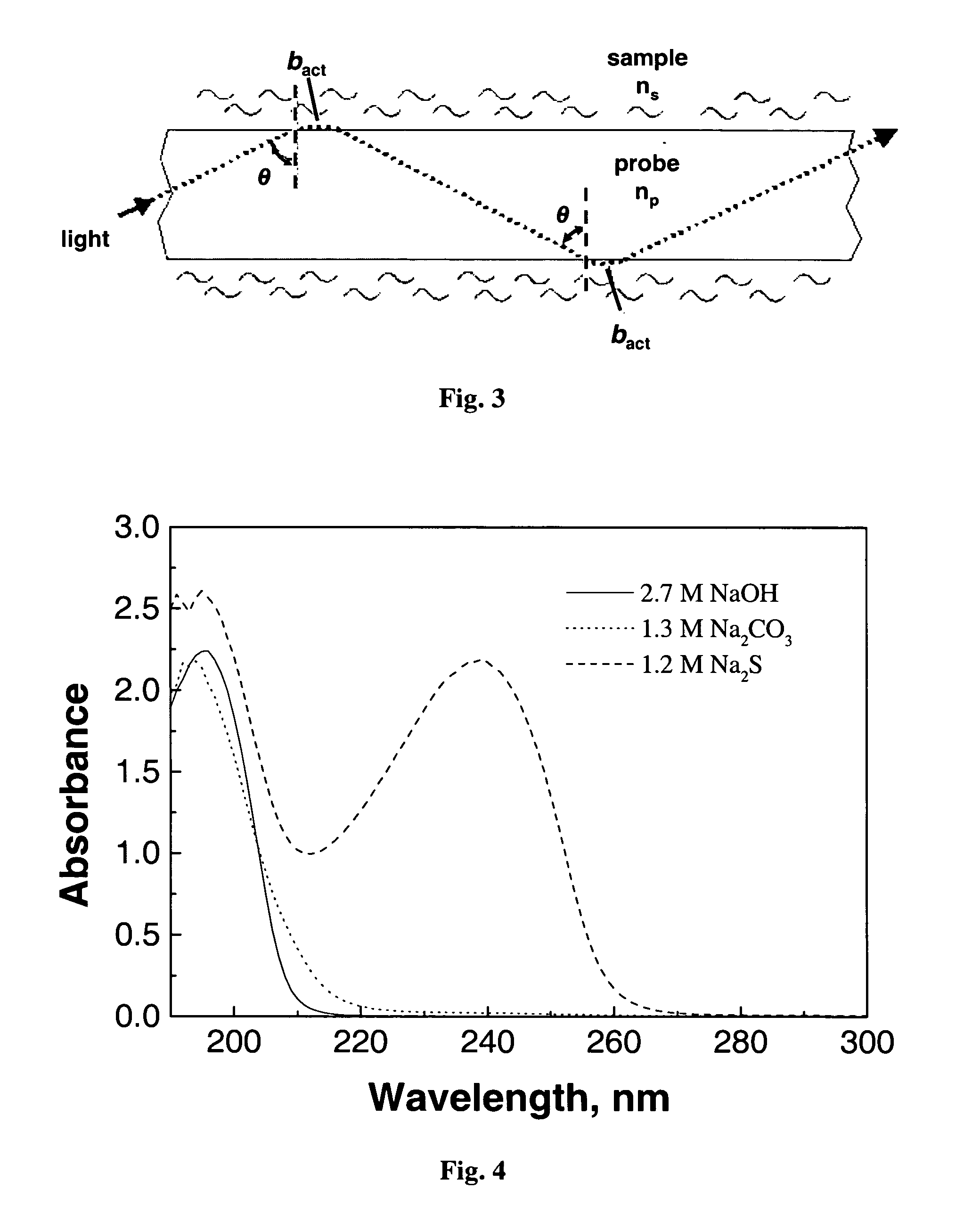Simultaneous and rapid determination of multiple component concentrations in a multi-component chemical process stream
a chemical process stream and concentration method technology, applied in the direction of optical radiation measurement, photometry using electric radiation detectors, instruments, etc., can solve the problems of limiting the application of conventional uv technology, requiring significant dilution of the process stream, and inability to provide useful absorbency data for conventional uv technology
- Summary
- Abstract
- Description
- Claims
- Application Information
AI Technical Summary
Benefits of technology
Problems solved by technology
Method used
Image
Examples
example 1
[0062] With chemometrical, a multivariate calibration program employing a PLS regression method, a calibration file used for predicting the concentration of typical components in kraft mill liquors was built. A training set of samples, covering the range of concentrations of effective alkali, sulfide and carbonate typically encountered in kraft mill white and green liquors was constructed and analyzed. Table 1 depicts the actual concentrations of the three components for each of the nine training samples used for the calibration model. FIGS. 9, 10, and 11 show the calibration graphs for EA, sulfide and carbonate, respectively. The linear relationships shown indicate the accuracy of the calibration models in predicted concentration. The calibration model accurately predicted the concentrations for EA and sulfide as illustrated by the linear relationships shown in FIG. 9. While the accuracy of the predicted concentration of carbonate suffered at low concentrations, kraft liquors rarel...
example 2
[0063] Using the method of Example 1, a training set of samples having a constant sulfide concentration of 0.5 M and varying concentrations of EA and carbonate, was used to build a calibration file. The variation of the EA and carbonate concentrations represents the variations of these concentrations generally found over the entire causticizing process. Table 2 depicts the actual concentrations of the samples compared to the predicted values. The data demonstrates that the inventive system provides an excellent means for determining EA and carbonate concentration during all points of the causticizing process.
TABLE 2Comparison between actual (Obs.) and predicted (by model) data.Concentration of EA, MConcentration of carbonate, MSampleObs.Pred.RSD, %Obs.Pred.RSD, %10.9710.9800.931.7481.743−0.2921.3351.329−0.451.5581.5610.19 3*1.6991.7382.291.3691.349−1.4642.0632.026−1.791.1801.1991.6152.4272.4681.690.9900.969−2.1262.7912.781−0.360.8010.8060.62 7*3.1553.2222.120.6120.577−5.7283.5193....
example 3
[0064]FIG. 11 shows the spectra of a group of kraft white and green liquors obtained from a paper mill. The spectra were obtained with a one-reflectance ATR prism and were used to build another calibration file. Because the absorption characteristics of each ATR prism is different, it is necessary to prepare multiple standard files. The new calibration file was designed to analyze a set of kraft liquors obtained from a kraft pulp mill. The measured concentrations of NaOH, Na2CO3 and Na2S by ABC titration, and predicted by the present method are listed in Table 3. Sample GL is a green liquor, while samples, WL-1, WL-2 and WL-3, are white liquors from different units of the causticizing plant. A strong correlation exists between the actual and predicted concentrations for Na2S concentration. The error between the actual and predicted concentrations for NaOH and Na2CO3 is negligible and quite acceptable for kraft mill process control purposes.
[0065] While the present invention has gen...
PUM
| Property | Measurement | Unit |
|---|---|---|
| wavelength | aaaaa | aaaaa |
| wavelength | aaaaa | aaaaa |
| wavelength range | aaaaa | aaaaa |
Abstract
Description
Claims
Application Information
 Login to View More
Login to View More - R&D
- Intellectual Property
- Life Sciences
- Materials
- Tech Scout
- Unparalleled Data Quality
- Higher Quality Content
- 60% Fewer Hallucinations
Browse by: Latest US Patents, China's latest patents, Technical Efficacy Thesaurus, Application Domain, Technology Topic, Popular Technical Reports.
© 2025 PatSnap. All rights reserved.Legal|Privacy policy|Modern Slavery Act Transparency Statement|Sitemap|About US| Contact US: help@patsnap.com



